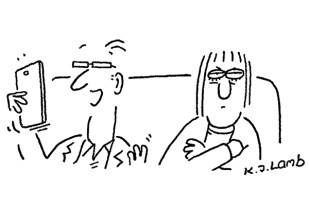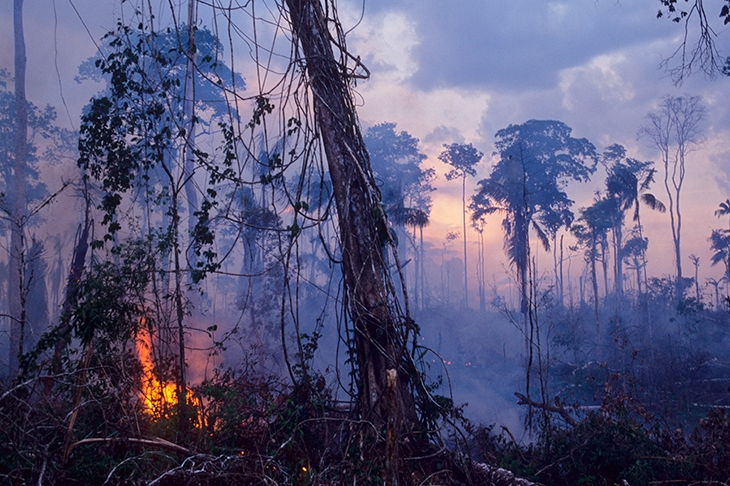Where to turn in anxious and febrile times? One answer is to nature, or the ‘non-human living world’, which, despite the ravages inflicted on it by humans, continues to offer solace and hope to many. Such, at least, is a possibility linking these fine but quite different books.
Lucy Jones’s starting point in Losing Eden is her own struggle with depression and addiction a few years back. She writes that three of the things that helped her recover — psychiatry, psychotherapy and the support of others — were straight-forward, but the fourth was more mysterious: a greater connection with the natural world. Surprised and interested, she embarked on investigating the power of nature to heal.
The result is a thorough, well-balanced report, even if it covers familiar ground. Carl Jung certainly recognised the importance of connecting with nature. Better health outcomes were apparent in the public housing projects built in Chicago in the 1960s with green spaces and trees than in those without. And gardening is well known to have marked benefits for those with severe mental health problems.
A sympathetic interviewer and scrupulous journalist, Jones visits project after project and cites study after study documenting the positive effects of time spent out of doors and in the wild. But why, she wonders, when the evidence of benefit is so compelling, do policy-makers not take ‘time in nature’ more seriously? And why do so many continue to perpetrate or tolerate its destruction?

She becomes increasingly radicalised as she investigates. Most children in the UK, she finds, spend less time outdoors during the school day than the UN deems the minimum permissible for hardened prisoners. She entertains concepts such as ‘equi-genesis’ — a proposal by Rich Mitchell of Glasgow University for increasingly equitable access to the natural world to reduce health inequalities between rich and poor. She is earnest but enlivened when she allows her mind, body and prose to go wild, as when she exuberates on the ‘chthonic hullabaloo’ of microbes in the Bialowieza subsoil.
The ecologist Aldo Leopold wrote that ‘the weeds in the city lot convey the same lesson as the redwoods’. The observation is quoted in Losing Eden, but it could equally stand as an epigraph to The Accidental Countryside. Here Stephen Moss explores Britain’s churchyards, road verges, railway cuttings and disused quarries that have become ‘hidden wildlife havens’. Home to sand lizards and stoats, adders and orchids,
butterflies and bush-crickets, water voles, peregrine falcons, great crested grebes and many other species, these scraps of land add up to an area larger than all our official nature reserves combined, and life is flourishing in all kinds of surprising ways, often with no human intervention.
The Accidental Countryside is in part a homage to Richard Mabey’s 1973 classic The Unofficial Countryside, which explored the untidy, neglected places where non-human life was finding a way to hang on and even thrive in defiance of all that 1970s Britain could throw at it. It is a worthy successor. Moss’s general outlook is that the glass is one hundredth full rather than 99 hundredths empty, and this hopeful stance is supported by delightful observations, from Mousa Broch in Shetland to Somerset’s Avalon Marshes:
Maybe at the 11th hour — or, more realistically, one minute to midnight — we will be able to change the way we manage the land, not just to benefit a narrow, self-serving clique of large landowners and multinational corporations, but for all of us.
Road verges, railway cuttings and disused quarries have become hidden wildlife havens
Tim Dee, a bird-watcher since boyhood and formerly a longtime producer of natural history programmes for BBC radio, is in love with the spring in the British Isles. But in Greenery he undertakes a pilgrimage across spring to its maximum conceivable extent, stretching it from February to June/July. He begins in South Africa, where he lives part of the year, and marvels at the swallows that will later fly to Britain and to the north of Norway. His desire — ‘to be in springtime for as long as possible’ — is framed by at least two seismic events: the pregnancy of his wife, the ornithologist Claire Spottiswoode, with their first son, and the discovery that he has Parkinson’s.
Greenery is as full of the sensibility and wit that marked Dee’s previous books — The Running Sky, about ‘birds and the sky they occupy’; Four Fields, about ‘the elemental matter that we stand on’; and Landfill, about seagulls and the people who love them. The prose is as sharp and agile as the beak and movements of his ‘most needed’ bird, the redstart, and the range of reference and thought is astonishing.
February finds him in Zakouma National Park in Chad on the edge of the Sahara — ‘thick with a mix of bird life: locals and migrants’. It may seem a strange place to look for spring, but ‘redstarts can only be in an oak wood in an English spring … because they have crossed this desert’.Travelling north, he visits the rock paintings at Ennedi, rich in their depictions of wildlife, made some 12,000 years ago when (within the species memory of many birds present, he speculates) the climate was milder, wetter and greener. A rocky bower leads to
a reverie on Dorothy Wordsworth’s Grasmere Journal, Book V of the Odyssey, and the music of Toumani Diabaté, before, in the middle of the desert, we meet three crocodiles, the last of their kind, in the guelta at Archei, and the ‘little trotty wagtails’, as John Clare called them
bouncing away in flight over the crocodiles, just as they do in supermarket car parks in Europe, where they gather flies from the radiator grilles and wheel arches of shoppers’ cars.
All three of these books emphasise nature’s power to heal, as well as our intricate and often tragic relationship to it. In times of pandemic especially, we need to know, and feel, more. As ecologists and science writers have warned us: ‘If we fail to understand and take care of the natural world, it can cause a breakdown … and come back to plague us.’






Comments